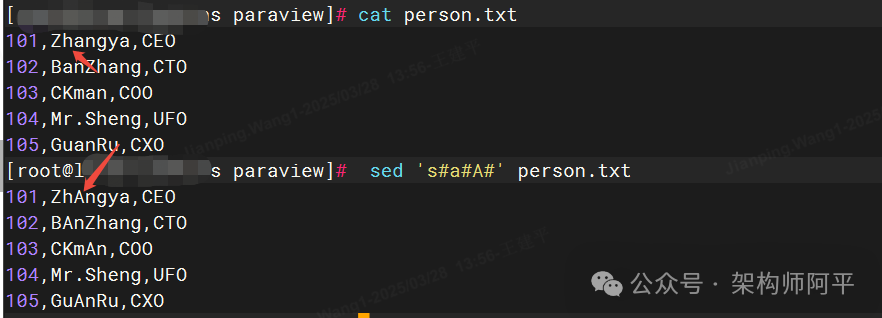|
The replacement function of sed is very powerful and is also the most common use of sed. By default, sed does not actually modify the file. If you want to write the modified content back to the file, you need to add the -i option. Command syntax: sed ‘[address range|pattern range] s#[keyword to be replaced]#[replacement keyword]#[replacement flags]’ [input file] Command explanation: 1. [address range|pattern range]: Optional. If not specified, sed will perform the replacement on all lines. 2. “s” means to execute the substitute command. 3. The string to be replaced can be a regular expression. 4. The replacement string must be a specific content. 5. Replacement flags: Optional. – Global flag g – Numeric flag (1, 2, 3…) – Print flag p – Write flag w – Ignore case flag i – Execute command flag e You can combine one or more replacement flags as needed. |
Testing textcat > person.txt <<EOF101,Zhangya,CEO102,BanZhang,CTO103,CKman,COO104,Mr.Sheng,UFO105,GuanRu,CXOEOFReplace CXO with XO If you want to display only the matching lines, you can combine the -n and p options as follows:
If you want to display only the matching lines, you can combine the -n and p options as follows:
sed -n "s#CXO#XO#gp" person.txt  To replace the second occurrence of a with A, use the following syntax:
To replace the second occurrence of a with A, use the following syntax:
sed 's#a#A#2g' person.txt To replace e or uppercase E with F, use the -r option for extended regex and i as follows:
Replace Specific Lines
Replace the first line of text with 200,DongLai,CEO

Group Replacement by Keywords
Replace the positions of CEO and numbers

sed -r 's#(.*),(.*),(.*)#\3,\2,\1#g' person.txt To remove the middle name, use the following:
sed -r 's#(.*),.*,(.*)#\1,\2#g' person.txt  Replace the first comma with – and the second comma with _. For example: 101-DongLai_CEO
Replace the first comma with – and the second comma with _. For example: 101-DongLai_CEO
sed -r 's#(.*)(,)(.*)(,)(.*)#\1-\3_\5#g' person.txt  Slow down, listen to the birds sing; or brew a pot of fragrant tea in the afternoon, enjoying a moment of tranquility and comfort; or send a greeting to a long-lost friend, conveying a deep longing. These seemingly ordinary little things can bring endless warmth and emotion to our lives.This concludes this episode! Stay tuned for the next one…
Slow down, listen to the birds sing; or brew a pot of fragrant tea in the afternoon, enjoying a moment of tranquility and comfort; or send a greeting to a long-lost friend, conveying a deep longing. These seemingly ordinary little things can bring endless warmth and emotion to our lives.This concludes this episode! Stay tuned for the next one…